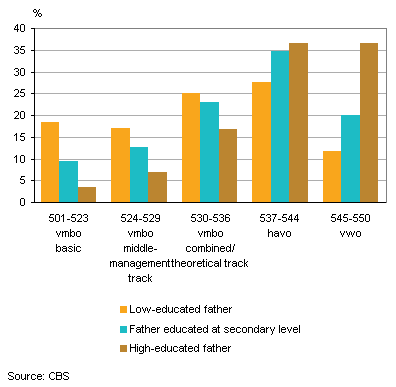Generally, boys perform less well than expected in secondary education, girls perform better

Statistics Netherlands announced today that boys and girls are doing equally well in primary education, but in secondary education girls outperform boys. In secondary education, boys and girls usually comply with the type of education that is consistent with the outcome of the Cito (Dutch National Institute for Educational Measurement) test, but after three years, many boys have moved down to a lower level of education, whereas girls often attend a higher type of education. Over the past 15 years, the proportion of pupils leaving secondary education without having graduated has also been higher among boys than among girls. Boys from low-educated families in particular often perform less well at school than might be expected on the basis of their Cito test results.
Children often follow in their parents’ footsteps
When leaving primary school, most primary school pupils do the Cito test. The outcome largely determines the type of secondary education they are going to attend next. On average, boys and girls perform equally well in the Cito test. There is a strong relation between the level of education of the father (or mother) and the Cito score. Children from low-educated families more often have lower results than children from high-educated families.
Cito score and type of education by level of education father

Children from high-educated parents much more often attend pre-university education
After three years in secondary education, this situation has not changed: children from low-educated fathers more often than average attend the lowest vmbo (lower secondary vocational education) learning track. If the father has secondary education, the children often attend higher vmbo tracks or havo (higher secondary general education). Children from fathers with a high level of education, most often attend vwo (pre-university education).
Type of education three years after Cito test by education level father

After 3 years boys have moved down, girls have moved up
Three years after having left primary school, most boys and girls attend a type of education which complies with the Cito test results. Fifty percent of children from low-educated fathers and no less than 60 percent of sons of high-educated fathers attend the type of education which could be expected on the basis of the Cito score. Boys (on average 24 percent) relatively often attend a lower type of education than might be expected on the basis of their Cito score, whereas girls (more than 30 percent) often perform better than expected and switch to a higher type of education. Children of high-educated fathers rarely move down to a lower type of education.
Type of education three years after Cito test by education level father
